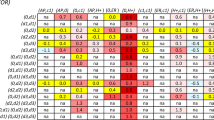Abstract
A haplotype marker consisting of three biallelic restriction fragment length polymorphism (RFLP) loci from theVH-2 variable gene family was examined in 124 families with sibling pairs concordant for multiple sclerosis, 178 unrelated patients and 159 unaffected controls to investigate the role of the immunoglobulin heavy chain gene cluster in susceptibility to multiple sclerosis. Evidence for linkage was assessed using the affected sibling pair method of identity by descent, modified to allow for haplotype sharing on a probabilistic basis in families where haplotypes could not be assigned with certainty. The estimated probabilities of affected siblings sharing 0, 1 or 2 haplotypes were Z0 = 0.20, Z1 = 0.45, Z2 = 0.35. This deviation from the expected sharing probabilities of Z0 = 0.25, Z1 = 0.5, Z2 = 0.25 provides evidence for weak linkage (P < 0.05; equivalent to a lod score of 0.84); however, no significant allelic or haplotypic association was observed. Linkage without a population association suggests that a gene encoded on14q confers susceptibility to multiple sclerosis, although this is not any of the existingVH-2 polymorphisms.
Similar content being viewed by others
References
Cox DW, Markovic VD, Teshima IE (1982) Genes for immunoglobulin heavy chains and for alpha-antitrypsin are localised to specific regions of chromosome 14q. Nature 297: 428–430
Gaiser CN, Johnson MJ, Delange G, Rasenti L, Cavalli-Sforza LL, Steinman L (1987) Susceptibility to multiple sclerosis associated with an immunoglobulin gamma 3 restriction length polymorphism. J Clin Invest 79: 309–313
Greenberg DA (1993) Linkage analysis of “necessary” disease loci versus “susceptibility” loci. Am J Hum Genet 52: 135–143
Hashimoto LL, Walter MA, Cox DW, Ebers GC (1993) Immunoglobulin heavy chain variable region polymorphisms and multiple sclerosis susceptibility. J Neuroimmunol 44: 77–84
Hawkins CP, Mackenzie F, Tofts P, Du Boulay EP, McDonald WI (1991) Patterns of blood-brain barrier breakdown in inflammatory demyelination. Brain 114: 801–810
Hillert J (1993) Immunoglobulin constant gene region polymorphisms in multiple sclerosis. J Neuroimmunol 43: 9–14
Hodge SE (1993) Linkage analysis versus association analysis: distinguishing between two models that explain disease-marker associations. Am J Hum Genet 53: 367–384
Holmans P (1993) Asymptotic properties of affected-sib-pair linkage analysis. Am J Hum Genet 52: 362–374
Kodaira M, Kinashi T, Umemura I (1986) Organisation and evolution of variable region genes of the human immunoglobulin heavy chain. J Mol Biol 190:529–541
Mumford CJ, Fraser MB, Wood NW, Compston DAS (1992) Multiple sclerosis in the Cambridgeshire health district of East Anglia. J Neurol Neurosurg Psychiatry 55:877–883
Mumford CJ, Wood NW, Kellar-Wood HF, Thorpe J, Miller D, Compston DAS (1994) The British Isles survey of multiple sclerosis in twins. Neurology 44: 11–15
Newcombe J, Hawkins CP, Henderson CL, et al (1991) Histopathology of multiple sclerosis lesions detected by magnetic resonance imaging in unfixed postmortem central nervous tissue. Brain 114: 1013–1023
Olsson T, Baig S, Hojeberg B, Link H (1990) Antimyelin basic protein and antimyelin antibodies in multiple sclerosis. Ann Neurol 27: 132–136
Ott J (1985) Analysis of human genetic linkage. John Hopkins University Press, Baltimore
Pandy JP, Goust JM, Salier JP (1981) Immunoglobulin G heavy chain (Gm) allotypes in multiple sclerosis. J Clin Invest 67: 1797–1800
Payami H,Thomson G, Motro U, Louis E, Hudes E (1985) The affected sib method. IV. Sib trios. Ann Hum Genet 49: 303–314
Pette M, Fujita K, Wilkinson D, et al (1990) Myelin autoreactivity in multiple sclerosis: recognition of myelin basic protein in the context of HLA-DR2 products by T lymphocytes of multiple sclerosis patients and donors. Proc Natl Acad Sci 87: 7968–7972
Poser CM, Paty DW, Scheinberg L (1983) New diagnostic criteria for multiple sclerosis: guidelines for research protocols. Ann Neurol 13: 227–231
Propert DN, Bernard CCA, Simons MJ (1982) Gm allotypes in multiple sclerosis. J Immunogenet 9: 359–361
Risch N (1990) Linkage strategies for genetically complex traits. III. The effect of marker polymorphism on the analysis of affected relative pairs. Am J Hum Genet 46: 242–253
Risch N (1990) Linkage strategies for genetically complex traits: the power of affected relative pairs. Am J Hum Genet 46: 229–241
Salier JP, Sesboue R, Martin-Mondiere C (1986) Combined influences of Gm and HLA phenotypes upon multiple sclerosis susceptibility and severity. J Clin Invest 78: 533–538
Scolding NJ, Compston DAS (1990) Oligodendrocyte-macrophage interactions in-vitro triggered by specific antibodies. Immunology 72: 127–132
Selmaj K, Raine CS, Farooq M, Norton WT, Brosnan C (1991) Cytokine cytotoxicity against oligodendrocytes. Apoptosis induced by lymphotoxin. J Immunol 147: 1522–1529
Southern EM (1975) Detection of specific sequences among DNA fragments separated by gel electrophoresis. J Mol Biol 98: 503–517
Suarez B, Hodge S (1979) A simple method to detect linkage for rare recessive diseases: an application to juvenile diabetes. Clin Genet 15: 126–136
Sun J, Link H, Olsson T, et al (1991) T and B cell responses to myelin-oligodendrocyte glycoprotein in multiple sclerosis. J Immunol 146: 1490–1495
Sun JB, Olsson T, Wang W-Z, et al (1991) Autoreactive T and B cells responding to myelin proteolipid protein in multiple sclerosis and controls. Eur J Immunol 21: 1461–1468
Tonegawa S (1983) Somatic generation of antibody diversity. Nature 302: 575–581
Walter MA, Gibson WT, Ebers GC, Cox DW (1991) Susceptibility to multiple sclerosis is associated with the proximal immunoglobulin heavy chain region. J Clin Invest 87: 1266–1273
Weinshenker BG, Bulman D, Carriere W, Baskerville J, Ebers GC (1990) A comparison of sporadic and familial multiple sclerosis. Neurology 40: 1354–1358
Zajicek JP, Wing M, Scolding NJ, Compston DAS (1992) Interactions between oligodendrocytes and microglia: a major role for complement and tumour necrosis factor in oligodendrocyte adherence and killing. Brain 115: 1611–1631
Author information
Authors and Affiliations
Rights and permissions
About this article
Cite this article
Wood, N.W., Sawcer, S.J., Kellar-Wood, H.F. et al. Susceptibility to multiple sclerosis and the immunoglobulin heavy chain variable region. J Neurol 242, 677–682 (1995). https://doi.org/10.1007/BF00866919
Received:
Revised:
Accepted:
Issue Date:
DOI: https://doi.org/10.1007/BF00866919




